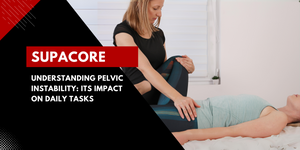Understanding Pelvic Instability: Its Impact on Daily Tasks
Pelvic girdle pain generally arises in relation to pregnancy, trauma, arthritis and osteoarthritis. Pain is experienced between the posterior iliac crest and the gluteal fold, particularly in the vicinity of the SIJ. The pain may radiate in the posterior thigh and can also occur in conjunction with/or separately in the symphysis.
The endurance capacity for standing, walking, and sitting is diminished.
Pelvic instability is a condition characterized by the excessive movement or misalignment of the pelvis, leading to discomfort, pain, and limitations in mobility for those affected.

This blog aims to shed light on the impact of pelvic instability on daily tasks and how it can affect an individual's quality of life.
Understanding Pelvic Instability: The pelvis plays a crucial role in our body's stability, serving as a connector between the upper and lower body. When the pelvis becomes unstable, certain muscles, ligaments, and joints fail to function optimally, leading to several issues. Causes of pelvic instability can vary, ranging from trauma and pregnancy to hormonal imbalances and muscle imbalances.
PELVIC INSTABILITY – what is it and do you have it?
Are you suffering from
- Pain: Pain in the pelvis, lower back, groin, or hips is a common symptom of an unstable pelvis. The pain may be worse when standing, walking, or climbing stairs.
- Instability: You may feel like your pelvis is shifting or moving out of place. This can make it difficult to maintain your balance and coordination.
- Difficulty with daily activities: You may have difficulty performing everyday activities, such as getting in and out of bed, sitting down, and standing up.
- Clicking or popping sounds: You may hear a clicking or popping sound when you move your pelvis. This is caused by the bones in the pelvis rubbing against each other.
These may be signs that you have an unstable pelvis and it is important to talk to your doctor or your physiotherapist and get a professional diagnosis.

Pelvic instability can impact on the following :
- Standing and Walking: One of the most immediate challenges faced by individuals with pelvic instability is maintaining stability while standing or walking. The misalignment of the pelvis can cause difficulty in weight-bearing, leading to a sense of uneven weight distribution, pain, and discomfort. Simple tasks like going for a walk or standing for prolonged periods become challenging due to this instability.
- Sitting: Sitting for extended periods can intensify pelvic instability symptoms. Individuals may experience pain, stiffness, or a feeling of instability while sitting. This can make it problematic to perform desk work, attend meetings, or even enjoy leisurely activities that involve prolonged sitting.
- Stairs and Changes in Elevation: Negotiating stairs or uneven surfaces becomes a daunting task for individuals with pelvic instability. The misalignment of the pelvis affects their balance and coordination, making it more challenging to climb stairs, walk on hills, or navigate unstable ground.
- Lifting and Bending: Pelvic instability can limit an individual's ability to lift heavy objects or perform tasks that require bending. The lack of stability in the pelvis can lead to poor alignment and compromised posture, resulting in increased strain on the spine and other joints. This can potentially contribute to further pain and discomfort.
- Impact on Sleep: Sleeping can also be affected by pelvic instability. Finding a comfortable position that alleviates pain becomes a constant struggle. Restlessness during the night due to discomfort can lead to sleep disturbances, fatigue, and hindered daily performance.
If you are suffering from any of these symptoms it is recommended that you seek medical advice.
Supacore Patented Coretech leggings and shorts are designed to help stabilize the pelvis. Read about our technology here and see how they can help you manage your everyday tasks.
References :
Vleeming, A., Albert, H. B., Östgaard, H. C., Sturesson, B., & Stuge, B. (2008). European guidelines for the diagnosis and treatment of pelvic girdle pain. European Spine Journal, 17(6), 794-819.
- https://www.ncbi.nlm.nih.gov/pmc/articles/PMC2518998/
- https://thepogp.co.uk/_userfiles/pages/files/stuge.pdf
- https://www.racgp.org.au/getattachment/64b34436-7407-4f9a-9380-9efd90f03274/Pelvic-instability.aspx

